For having stamped the compostela along the Camino -and thus accrediting a journey of more than 100 km on foot- I was able to request the Pilgrim’s Certificate at the Pilgrim’s Office. It is a printout of a text in Latin and is free of charge. For an additional cost, they offer you a special certification, which I didn’t even try to understand when they wanted to explain it to me. In addition, they sell you a cardboard canute for 3 € so you can carry it rolled up and it won’t bend if you don’t have a place to put it. Merchandising, whatever you want. I took with my cell phone the photo below on a table that was there, while it was shiny and straight, and then to the backpack and off it went.
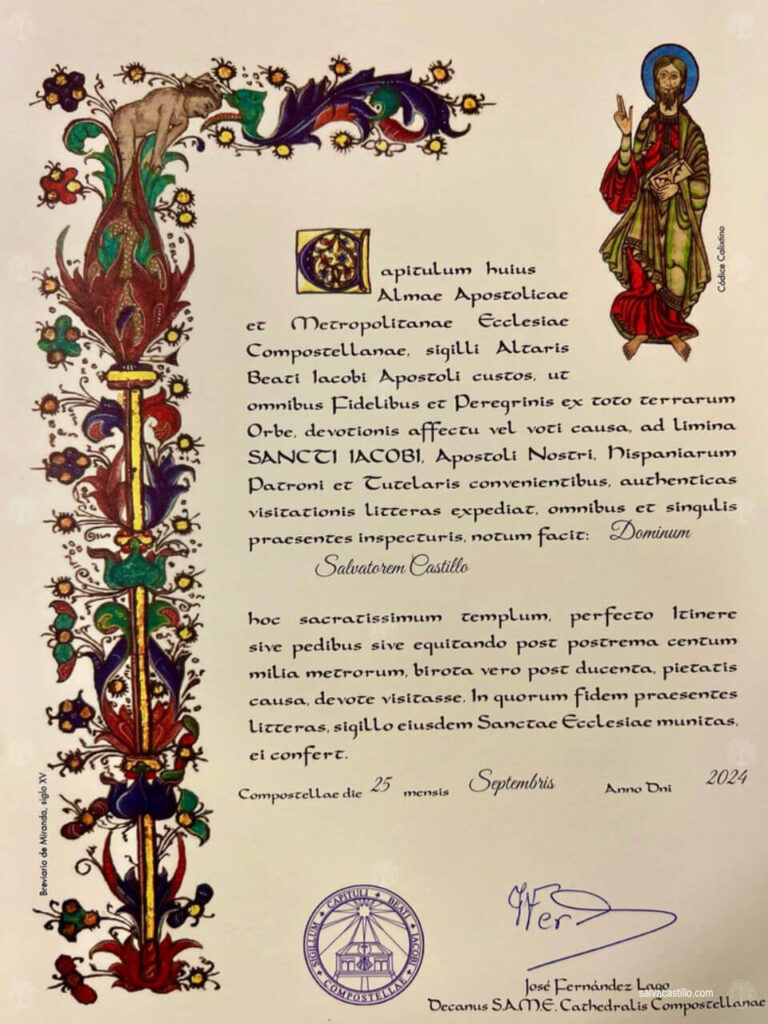

The squall Aitor was hovering over the city. This big storm was already making headlines in the news as it was expected to wreak havoc in Galicia. It rained all day except for a few moments when the sky opened up. In one of these truces I returned to the Plaza del Obradoiro to immortalize the Cathedral without mist, with an intense blue sky.

The ornamentation of the front of the Cathedral is overwhelming.
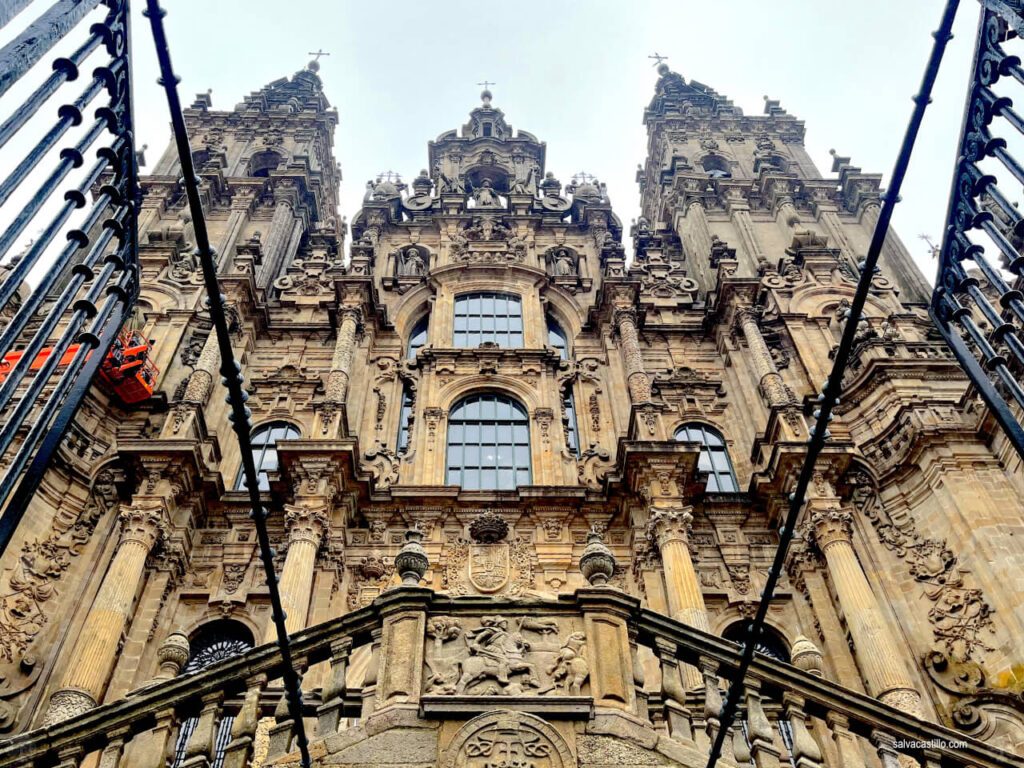
I returned to contemplate the hustle and bustle of the pilgrims as they reached their goal of reaching the Plaza del Obradoiro. Those who arrived at that moment could lie down on the floor of the square, as usual, because it had dried out in the sun. Instagrammers were having a blast!

View of the Cathedral of Santiago through the entrance door, with the “Fonte dos cabalos” with the Arca Marmórica and the female holding the Star of Compostela.
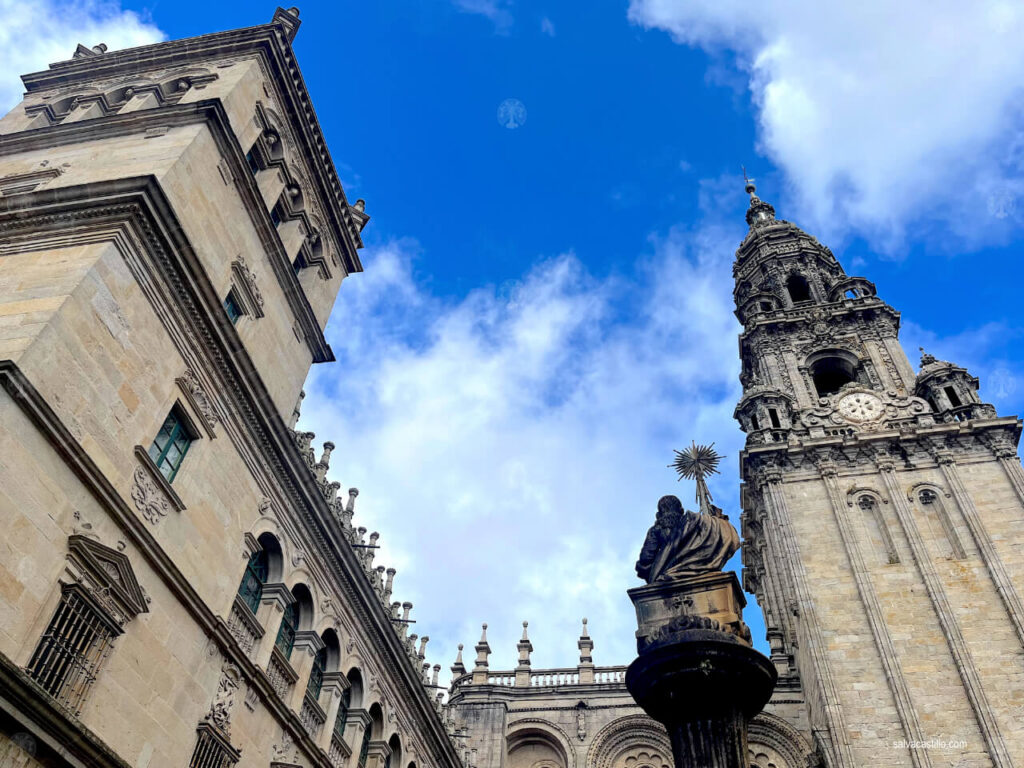
Santiago is a monumental city whose old town is full of remarkable corners. The churches and buildings exhume centuries of contemplation and its long porticoes running for hundreds of meters give it the appearance of a medieval city.
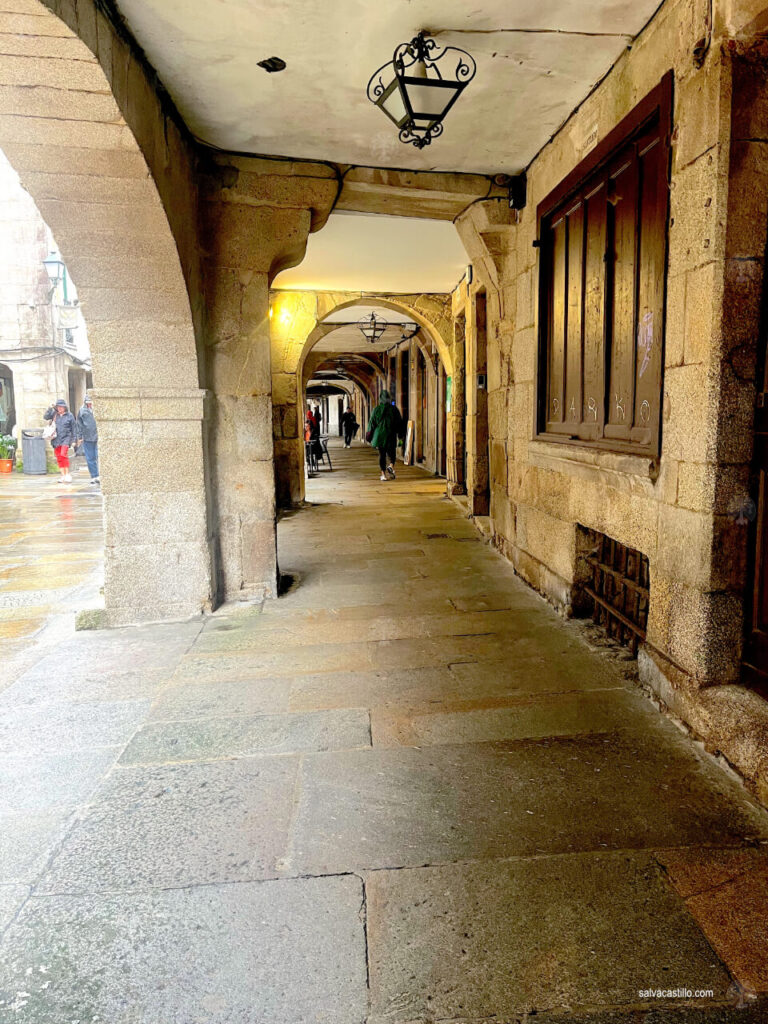
The La Iglesia de San Martiño Pinairo was built in the twelfth century and has a beautiful baroque facade, and presides over a charming square.

In Santiago it is also customary, as in Granada, for bars to serve a tapa with the drink. Recommended by my family, I decided to go to the famous bar-hospedaje “La Tita”. Their tortilla “half-set up” is famous in Santiago. It is small, and you have to wait in line to get in. But the tortilla was so good that I returned back the next day.
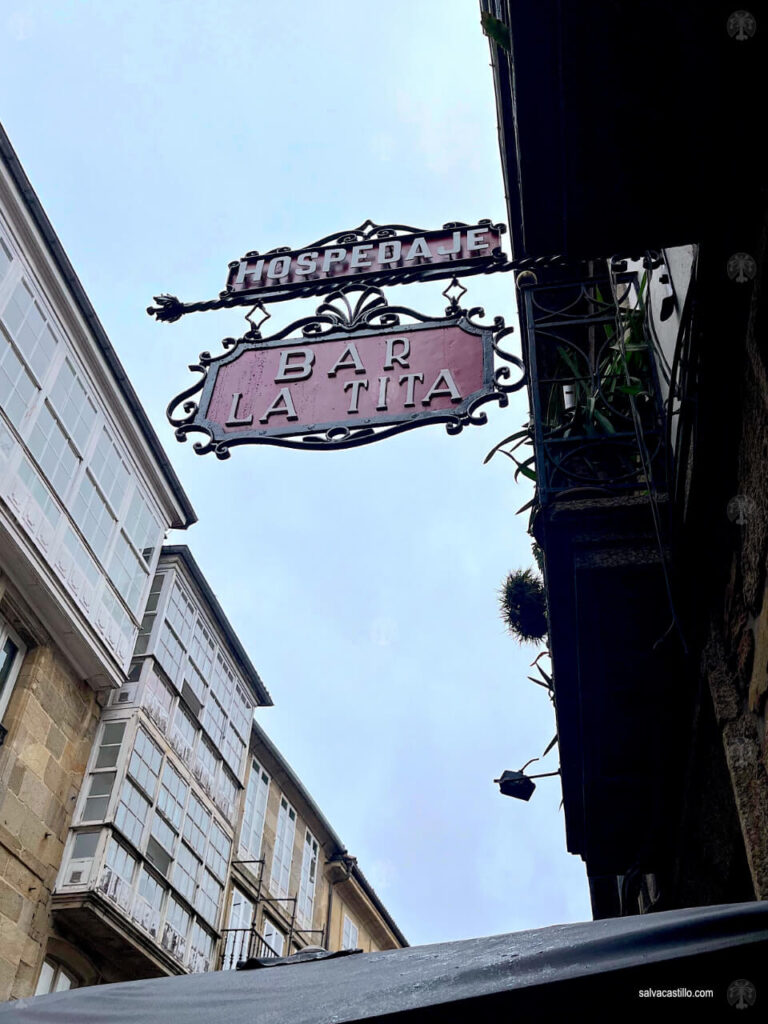
In the evening, the storm Aitor was already raging and brought a lot of rain and wind. For safety reasons, the City of Santiago closed the parks to avoid injuries due to falling trees. I lost myself and started to explore cafes and bars in the rain and found a jewel in the Pub Modus Vivendi. In the afternoon, while I was reading a book and drinking a patxarán, rock ballads in the style of Nick Cave or Tom Waits were playing. I could hear the pouring rain through the windows.
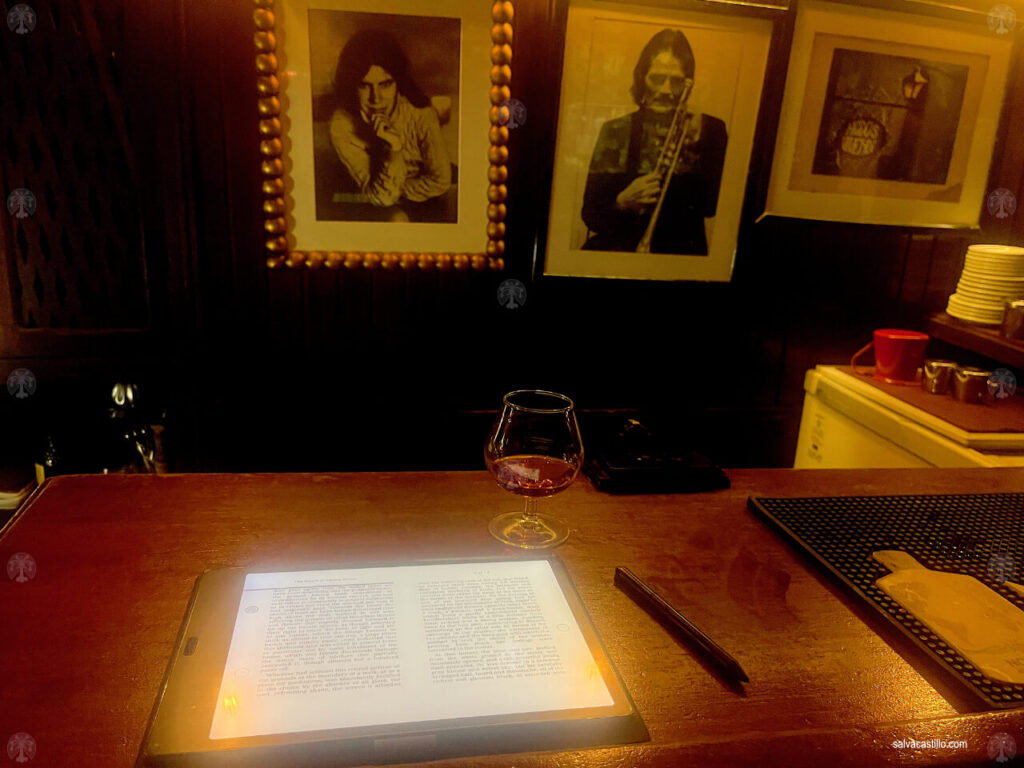
Later Santiago said goodbye to me with a memorable night that made me feel that life is a breath of fresh air, and that twenty years is nothing. But the time always comes for the traveler to depart and leave behind those sweet memories. “Ultreia et Suseia” forever 🫶🏻.

My balance
This Way has strengthened my trust in others; I have met many very kind people and also exceptional people. It is true that the profile of the pilgrim in the microcosm of the Way does not correspond 100% with the average person you meet in the supermarket queue. It is well known how we are psychologically influenced by the “group effect” in our behavior. When we are surrounded by violence and harassment, in general people tend to be more violent. Maybe on the Camino the effect is the same but in an inverse context: we are part of a group of people facing a challenge – bigger or smaller depending on each one – and where no one is safe from suffering a mishap or a fainting spell. The rule of inclusion in the pilgrim community is respect and selfless help.
There is a psychological study -which I read at the time and now I can’t find, when I find it I will post it here- much more interesting that exposes how people express or behave in a certain way not because they are convinced or that behavior is a fundamental part of their character, but because it is what they perceive that the rest of the group/community expects them to say or do. It is pure conformity to the group to seek their acceptance. The paradox is that, as no one dares to share what they really think, there may be situations in which a subgroup that is the actual majority thinks and feels internally the opposite of what it expresses, when being the majority group, those self-censored thoughts are what should define the group as a whole and dissidents have to conform to it. In short, the repression of our ideas and the unbereable fear of group censorship means the death of our identity as individuals.
As for my resolutions before starting the Way, I think I have reasonably fulfilled them. I have shared my living space with total naturalness and without any stress. As for talking, I talked a lot, but as much as I listened. And then I tasted the food I was offered, without any squeamishness -now I have to find where to buy Arzúa-Ulloa cheese -or Tetilla cheese- in Córdoba.🙂
My physical condition has improved significantly, because I had no other option than to finish each stage.
This is not my last Santiago’s Way 🫶🏻
Historical controversy: is it really the Apostle James who is buried in the Cathedral?
I have left for the end the most controversial part. TLDR; it is very unlikely.
The Apostle James (his name can also be translated as Jacob – Xacobeo year 😉) was the son of Zebedee and Salome, and one of the three apostles closest to Jesus along with his younger brother John and Peter. They were the only three to witness the transfiguration of Jesus Christ on Mount Tabor, the only ones to witness the resurrection of the daughter of Jairus, and the ones who accompanied Jesus in the garden of Gethsemane.
James was martyred and beheaded in Jerusalem in the year 44 by Herod Agrippa I of Judea, as is accepted from a strictly historical point of view, and also it appears in the Bible (Acts 12:1-3). So it is quite improbable that he traveled to what is now Spain and crossed it from part to part evangelizing and being martyred as the Catholic tradition claims. He just didn’t have time, considering other places where he is attested to have been at the same time.
Nevertheless, some Catholic historians said he landed in Galicia. Others, that he landed in Tarragona. And having already begun his evangelizing journey, the Virgin appeared to him on top of the shaft of a column in the city of Caesar Augusta, which becomes the Virgin of the Pillar of Zaragoza. However, the first Catholic historians in Spain and Portugal (IV to VII centuries) never mention the apostle evangelizing Spain. It is very difficult to imagine that it did not seem to them a relevant fact to include in their writings. The Apocryphal Acts of St. James always place him geographically in the region of Judea. The Catholic historians who do place the Apostle James in Spain are those of several centuries later (ninth century and later).
Let us not forget that James is the patron saint of Spain. And the Virgin of Pilar is the patron saint of the Hispanidad, of the Civil Guard corps, of Zaragoza, of Aragon, and of the Post and Telegraphs service. She is also Captain General of the Spanish Army. It cannot be that all of that is a hoax. It is too important.
Pope John Paul II was praying in the crypt of St. James the Apostle during his visit in 1989. According to Catholic doctrine, the Pope, as the representative of the Catholic people on earth, is the only one who has direct communication with God through the Holy Spirit. And although he is elected by the rest of the cardinal purpurate, they are all enlightened by the grace of the Holy Spirit to vote for the right pope – only sometimes they don’t listen to Him, because they are human and they also sin and have their quarrels and their selfishness and all that… the mental gymnastics necessary to justify it is of a fascinating exuberance.
Thus, the veracity of the tomb of the Apostle James is fully corroborated by the Holy Catholic Apostolic and Roman Church in the figure of the Holy Father himself.
So, if the Bible itself indicates that the Apostle was martyred and executed in the year 44, how did his corpse reach Santiago de Compostela? Very simple: according to Christian tradition, his disciples, who knew how much he loved Spain, decided to put the remains of his body in a boat without a rudder – it didn’t matter, since James and his brother John were fishermen in Galilee – which crossed the Mediterranean Sea and reached the Galician town of Iria. After a series of vicissitudes with the local government, they arrived at Iria Flavia (today Padrón) and buried him there somewhere unmarked. The two disciples who remain in the area (self)became bishops and continue evangelizing. Not much is known about all this for 9 centuries until Florus of Lyon, a very influential politician and ecclesiastical writer and Deacon of Lyon – that is, a man who sat several hours a day at a desk writing things down – establishes it in the 9th century by adding passages to the pre-existing Martyrology of St. Bede the Venerable. What he added is already part of the canon of Catholic doctrine and to doubt its veracity is to doubt the Church itself.
It is curious that when an account of which we have no reliable evidence validates the Christian canon, it is considered “tradition”, but when it contradicts it or has pagan origin, then it is “legend”.
If the tomb was lost in the middle of the mountain, how did the body reach the crypt of the Cathedral? During the years of the Muslim invasion of the Iberian Peninsula the area is very depopulated and all traces -if there ever were any- are lost. But in the year 816 a local named Pelagius saw some strange lights on a mountain. He warned the bishop, who had the place excavated, and they found a tomb with a body with a decapitated head next to the coccyx. Mysterious lights, a decapitated man… The Apostle James himself was showing them where he was buried! The bishop sent letters to Pope Leo, and the news spreaded throughout the Christian world. The Asturian King Alfonso II El Casto, a devout and God-fearing man, decided to travel to where the body was found to check whether or not it was really the body of the Apostle. He decided that it was, and there he ordered a church to be built to house it. The King is, then, the first pilgrim to the tomb of the Apostle, and his example and popularity spread among Christianity, which over the centuries has travelled the Primitive Way. Donations increased, and with them, in 1122, the Cathedral of Santiago de Compostela was completed, where the archiepiscopal headquarters were transferred from Iria Flavia. From that moment on, Santiago de Compostela rivaled Rome and Jerusalem as the emblematic city of the Christian faith, with the benefits that this implied for Spain.
But if the body found decapitated is not that of the Apostle Jame, whose is it? Well, several prestigious historians and philosophers such as Louis Duchesne, Unamuno, Sánchez Albornoz, and Sánchez Dragó defend that the decapitated body belongs to another member of the Catholic Church. Priscillian was a 4th century Galician monk who became an influential Bishop of the Church. But he preached a way of professing Christianity that was opposed to the prevailing orthodoxy in Christianity – where women participated in the ritual, defended the return to apostolic humility, celibacy was not obligatory, night masses were held, they went barefoot and with long hair … – and was the origin of an ascetic movement called Priscillianism. He caused the summoning of two Councils to reprimand him. Tried – and tortured – in an ecclesiastical court and condemned for witchcraft and heresy to death by decapitation, he was the first person executed for ecclesiastical reasons in the history of the Catholic Church. His disciples, with the permission of the Church, moved his body from Trevere (Augusta Treverorum, in today’s Germany) to Iria Flavia, where he was originally from.
Ah, the ironies of fate could not be more disturbing: that in one of the world symbols of Catholicism, a heretic condemned to death by the Catholic Church itself is actually venerated.
Carbon-14 dating tests have been suggested on the remains in the crypt. This would make it possible to discern whether it is a body from the 1st century, the 4th century, or some other century. The church has refused to do so.
I transcribe Juan Eslava Galán in his absolutely delicious book “Catholicism explained to the sheep”: the word Compostela derives according to some from compositum, “cemetery”, and according to others from campus stellae, “field of stars”, because of the lights that were observed on the mountain and that attracted the curious Pelagius. It is possible that they were fatuous fires, a natural phenomenon produced by oxidation of phosphine and methane released precisely from organic decomposition in swamps and cemeteries.
Another very interesting theory ascribes the beginning of the hidden myth of the tomb of James to Mozarabs exiled in the VIII century in Galicia from the Caliphate, who took with them the stories of the first Christians – The Seven Apostolic Men – who disembarked on the coast of Almeria in the first century.
I make this exposition for the sake of completeness. If you know me personally, you may have already noticed that I will leave no stone unturned when something catches my interest. All along the Way I have been immersed in a religious environment -as it could not be otherwise- and I have witnessed with all respect the acts of faith of the pilgrims -a family praying under a bridge, or Mr. E. handing out stamps with passages from the Bible. My motivation was not religious, but while I may not practice the Christian religion 100%, there is no doubt that Christian culture and tradition are structurally imbued in my personality and values. And I do believe that is a good thing. I do respect and love everybody.
For a while I professed Pastafarianism where I worshipped the Flying Spaghetti Monster, which is nothing more than a satirical religion that was born to defend freedom of belief in the USA and the separation between state and church, specifically in public schools, which I agree with. So it is not a movement with a spiritual background, but an anti-religious movement. And it did not grow on me.
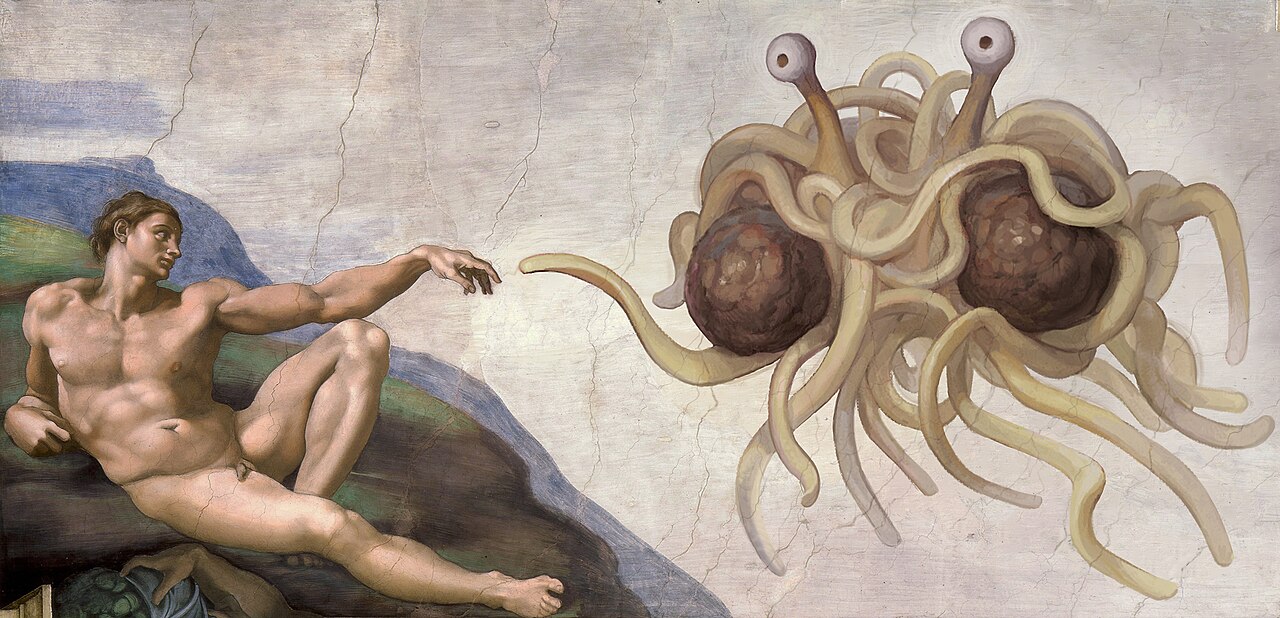
However, I did become a self-ordained priest in the Church of the Latter Day Note back in 2017. In Dudeism we do profess a bizarre variant of Taoism based on the character “The Dude” from the movie “The Big Lebowski” 🤪 . No kidding, in some counties in some US states I can officiate religious weddings.

So do not get too frisky because I am watching you, you sinners… 😈
Buen camino… ¡y buena vida!